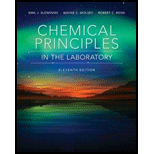
Concept explainers
As pure elements, all of the halogens are diatomic molecular species. Their melting points are:
Elemental formula: ______ Phase at room temperature: ______
Interpretation:
The elemental formula and phase of elemental astatine are to be stated.
Concept introduction:
The periodic table is an important part of chemistry. In this table, all known elements are arranged on the basis of their atomic number. Elements having same outer electronic configuration are kept in same groups. The elements on left of periodic table are metals, on right are nonmetals and in center are transition metals and metalloids.
Answer to Problem 1ASA
The elemental formula of astatine is
Explanation of Solution
The elemental forms of other members of astatine group are
The melting points of
Since astatine is present after iodine in the group, therefore, its melting point is higher than
So,
The elemental formula of astatine is
Want to see more full solutions like this?
Chapter 12 Solutions
Chemical Principles in the Laboratory
- Which of the following are isotopes of element X, the atomic number for which is 9: 919X, 920X, 189X, and 921X?arrow_forwardHundreds of years ago, alchemists tried to turn lead into gold. Is this possible? If not, why not? If yes, how would you do it?arrow_forwardIt is good practice to actively read the textbook and to try to verify claims that are made when you can. The following claim is made in your textbook: “. . . if the nucleus were the size of a grape, the electrons would be about 1 mile away on average.” Provide mathematical support for this statement.arrow_forward
- you are designing a rocket engine th uses a mixture of hydrazine and water as a propellant. this engine will be mounted to an unmanned drone bound for hydrazine for the return launch. how much will this hydrazine weigh on the surface on venus express this quanitity in Newtons. the molecular formula of hydrazine is N2H4, you may assume the molecular weights of nitrogen and hydrogen are 14 and 1 g/mol, respectivly. Gravitational acceleration on Venus is 8.87m/s^2.arrow_forwardWhat is the differences between an Oxygen atom (16 amu, atomic number = 8) and a Calcium atom (46 amu, atomic number = 20) in terms of their atomic structures and chemical properties.arrow_forward5 g of anhydrous strontium nitrate is added to a beaker and exposed to the air. After several hours the beaker and the contents are weighed. It was found that the mass increased by 1.70 g. Assume that the increase in mass is totally due to the absorption of water by the anhydrous compound. What is the percentage of water in the hydrated sample?arrow_forward
- Group the following elements according to similar properties: As, I, Ne, F, Mg, K, Ca, Ba, Li, He, N, P.arrow_forwardA research investigation was performed using Alka-Seltzer and water. During the investigation, which of the following MUST be reported in proving the law of conservation of mass? A The definition of the law of conservation of mass in the reaction. B How conservation of mass relates to the exercise performed to bring the change in mass. C The mass of the Alka-Seltzer tablet, the mass of water that reacted, and the mass of products. D The mass of the Alka-Seltzer tablet, the mass of water, the mass of all the products.arrow_forwardDescribe the ideas of the Ancient Greeks on the atom and elements; Describe the contributions of the alchemist to the science of chemistry.; Point out the main ideas in the discovery of the structure of the atoms and their sub-atomic particles. Explain how the concept of atomic number leads to the synthesis of new elements in the laboratory; Write the nuclear reactions involved in the synthesis of the new elements. Some applications of radioactive decay. Give at least 10 sentences in each question.arrow_forward
 Introductory Chemistry: A FoundationChemistryISBN:9781337399425Author:Steven S. Zumdahl, Donald J. DeCostePublisher:Cengage Learning
Introductory Chemistry: A FoundationChemistryISBN:9781337399425Author:Steven S. Zumdahl, Donald J. DeCostePublisher:Cengage Learning Principles of Modern ChemistryChemistryISBN:9781305079113Author:David W. Oxtoby, H. Pat Gillis, Laurie J. ButlerPublisher:Cengage Learning
Principles of Modern ChemistryChemistryISBN:9781305079113Author:David W. Oxtoby, H. Pat Gillis, Laurie J. ButlerPublisher:Cengage Learning Chemistry: The Molecular ScienceChemistryISBN:9781285199047Author:John W. Moore, Conrad L. StanitskiPublisher:Cengage Learning
Chemistry: The Molecular ScienceChemistryISBN:9781285199047Author:John W. Moore, Conrad L. StanitskiPublisher:Cengage Learning Chemistry & Chemical ReactivityChemistryISBN:9781337399074Author:John C. Kotz, Paul M. Treichel, John Townsend, David TreichelPublisher:Cengage Learning
Chemistry & Chemical ReactivityChemistryISBN:9781337399074Author:John C. Kotz, Paul M. Treichel, John Townsend, David TreichelPublisher:Cengage Learning Chemistry: Principles and PracticeChemistryISBN:9780534420123Author:Daniel L. Reger, Scott R. Goode, David W. Ball, Edward MercerPublisher:Cengage Learning
Chemistry: Principles and PracticeChemistryISBN:9780534420123Author:Daniel L. Reger, Scott R. Goode, David W. Ball, Edward MercerPublisher:Cengage Learning Chemistry & Chemical ReactivityChemistryISBN:9781133949640Author:John C. Kotz, Paul M. Treichel, John Townsend, David TreichelPublisher:Cengage Learning
Chemistry & Chemical ReactivityChemistryISBN:9781133949640Author:John C. Kotz, Paul M. Treichel, John Townsend, David TreichelPublisher:Cengage Learning





